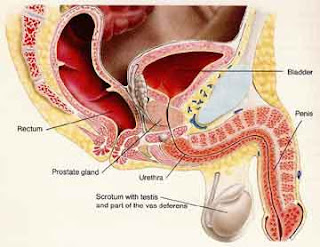Hirschsprung's Disease - Nursing Diagnosis and Interventions
 Hirschsprung's disease is a blockage of the large intestine due to improper muscle movement in the bowel. It is a congenital condition, which means it is present from birth.
Hirschsprung's disease is a blockage of the large intestine due to improper muscle movement in the bowel. It is a congenital condition, which means it is present from birth.Symptoms that may be present in newborns and infants include:
- Difficulty with bowel movements
- Failure to pass meconium shortly after birth
- Failure to pass a first stool within 24 - 48 hours after birth
- Infrequent but explosive stools
- Jaundice
- Poor feeding
- Poor weight gain
- Vomiting
- Watery diarrhea (in the newborn)
Symptoms in older children:
- Constipation that gradually gets worse
- Fecal impaction
- Malnutrition
- Slow growth
- Swollen belly
It is diagnosed by taking a small piece of tissue from the bowel to examine under a microscope. This is called a rectal biopsy. If the piece of tissue does not have any ganglion cells, this means Hirschsprung’s disease has been diagnosed.
Nursing Diagnosis and Interventions for Hirschsprung's Disease
1. Constipation related to obstruction
The inability of the colon to evacuate stool (Wong, Donna, 2004: 508)
Goal: Children can perform elimination with some adaptations to function normally and eliminations can be done.
Expected outcomes:
- Patients can perform elimination with some adaptation.
- There is an increased elimination pattern better.
Intervention:
- Provide assistance enema with 0.9% NaCl physiological fluids.
- Observation of vital signs and bowel every 2 hours.
- Observation expenditure per rectal stool: form, consistency, amount.
- Observations affecting intake patterns and stool consistency.
- Recommended for the diet that has been recommended.
Goal: The patient receives adequate nutrition in accordance with the recommended diet.
Expected outcomes:
- Weight loss patients according to age.
- Patient's skin turgor moist.
- Parents can choose the recommended foods.
Intervention
- Provide adequate nutrition in accordance with the recommended diet.
- Measure the child's body weight per day.
- Use alternate routes nutrition (such as NGT and parenteral) for those patients who had started to feel nauseous and vomiting.
3. Risk for Fluid Volume Deficit related to intake less (Betz, Cecily & Sowden 2002:197)
Goal: hydration status of patients can meet the body's needs.
Expected outcomes:
- Moist skin turgor.
- Fluid balance.
Intervention
- Provide adequate fluid intake in patients.
- Monitor signs turgor adequate body fluids, intake - output.
- Observation of increased nausea and vomiting, anticipated deficit of body fluids immediately.
4. Knowledge Deficit: about the disease process and treatment.
Goal: patients' knowledge about the disease to be more adequate
Expected outcomes:
- Knowledge of the patient and family about the disease, treatments and medications increased.
- Give a chance to the patient's family to ask for the things he wants to know in relation to the disease being treated.
- Assess family knowledge about Mega Colon.
- Assess family background.
- Explain about the disease process, diet, treatments, and medicines to the patient's family.
- Explain all the procedures that will be implemented and the benefits for patients.



